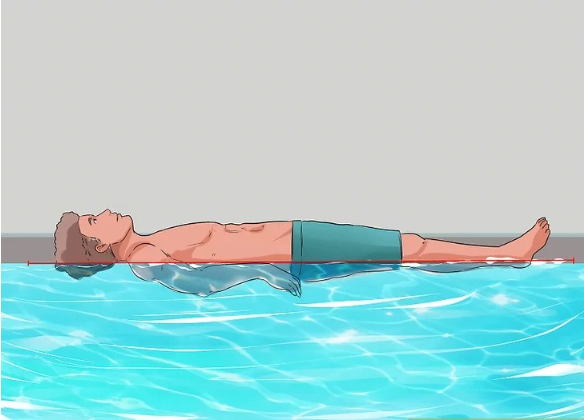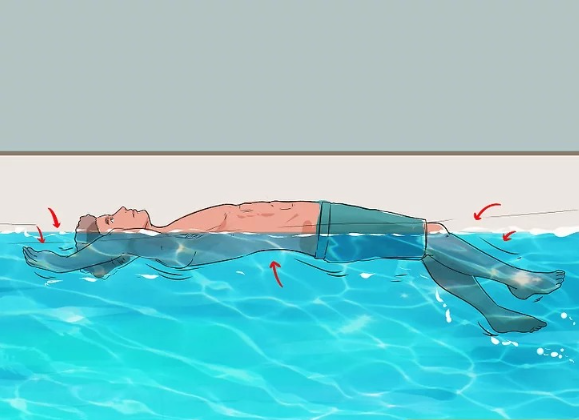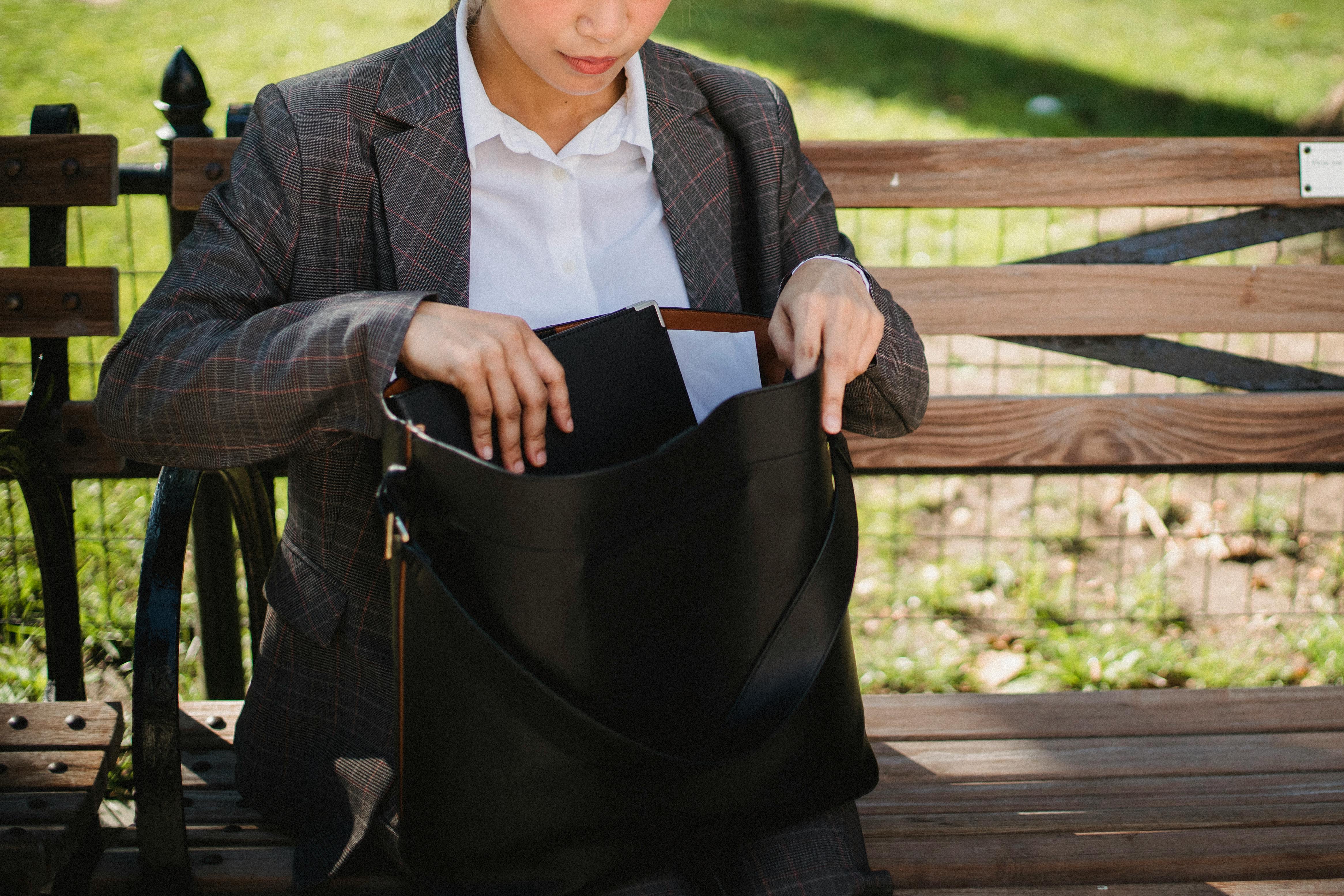Falling into deep water unexpectedly can be a terrifying experience, especially if you don’t know how to swim. Panic sets in, your instincts tell you to struggle, and before you know it, you’re exhausted and in real danger. However, survival in such a situation is entirely possible if you remain calm and follow a set of simple but life-saving steps.
According to Dr. Nash and his team of researchers, the key to survival is overcoming fear instincts and following five crucial steps. These steps are designed to help anyone—regardless of swimming ability—stay afloat, breathe, and increase their chances of rescue. Let’s dive into these life-saving techniques.
1. Stay Calm and Relax to Achieve Natural Buoyancy

The first and most critical step is to fight the urge to struggle. Many people instinctively flail their arms and legs in a desperate attempt to stay above water. However, this only wastes energy and causes faster exhaustion.
Instead, take a deep breath and allow your body to relax. When you stop panicking, your body will naturally float closer to the water’s surface. The human body is slightly less dense than water, meaning that if you remain still, you can achieve buoyancy without much effort.
2. Tilt Your Head Back to Keep Your Airway Clear
Once you’ve calmed yourself and started floating, you need to ensure that you can breathe. The best way to do this is to tilt your head back, keeping your face above the water.
Try not to move too much, as sudden movements can make you sink slightly. If you feel yourself going under, resist the urge to panic—simply take a deep breath, relax your muscles, and allow yourself to rise again.
Video : How to Survive if You Fall in Water – Prevent Yourself From Drowning – Survival Techniques
3. Breathe Slowly and Avoid Inhaling Water
Now that your nose and mouth are above water, it’s time to focus on breathing. Many people instinctively gasp for air, but this can lead to choking if water splashes into your mouth. Instead, practice controlled breathing:
- Exhale slowly through your nose to clear any water that may have entered.
- Inhale through your mouth in a controlled manner.
- If a wave covers your face, hold your breath momentarily, then resume normal breathing.
Even experienced swimmers can struggle if they inhale water, so maintaining steady breathing is crucial for survival.
4. Move Your Arms and Legs Gently to Stay Afloat
At this point, you should be floating on the water’s surface and breathing steadily. The next step is to use gentle, controlled movements to maintain your position.
- Use slow arm movements: Move your arms in a sweeping motion, like you’re making small circles in the water. This will help you stay afloat without expending too much energy.
- Legs should remain still if you don’t know how to kick properly: If you’re unsure how to tread water, keeping your legs still is often better than kicking randomly. Let them sink slightly while focusing on keeping your upper body above water.
The key here is to avoid frantic movements—slow and deliberate strokes will keep you afloat much longer.

5. Look for Rescue Opportunities
Once you’ve gained control of your breathing and movements, your next priority is finding a way to safety.
- Scan your surroundings – Look for anything floating that you can grab onto, such as a buoy, a log, or even a piece of debris. Holding onto something will help you conserve energy.
- Check your distance from the shore – If you can see land, assess whether it’s possible to move toward it using slow, steady movements.
- Signal for help – If there are people nearby, shout for help. However, conserve energy by calling out only when necessary.
If you’re caught in a strong current, do not try to swim directly against it—this will only tire you out. Instead, swim diagonally at an angle to gradually move out of the current’s pull.
What to Do If You See Someone Drowning
If you witness someone struggling in deep water, it’s important to act quickly but safely. Jumping in to rescue them may seem like the right thing to do, but unless you’re a trained rescuer, it could put both of you at risk.
Instead, follow these steps:
- Shout instructions – Encourage the person to follow the survival steps above. Remind them to relax, tilt their head back, and float.
- Find a flotation device – If possible, throw a life jacket, a rope, or any floating object they can grab onto.
- Call emergency services – Immediately contact your local emergency number and provide details of the situation.
Video : How to get over fear of water – Feel safe on the deep end
Why Staying Calm is the Key to Survival
Many drowning incidents occur not because the victim physically sinks, but because they panic and exhaust themselves. Learning how to override panic instincts and follow a survival routine can mean the difference between life and death.
Dr. Nash explains:
“Whether you’re planning a vacation, taking a walk near a river, or going for a swim, knowing how to stay safe in water is crucial. These simple survival techniques can save your life or someone else’s.”
Final Thoughts
Surviving a fall into deep water without knowing how to swim is possible—but only if you remain calm and follow the right steps. By floating, maintaining steady breathing, and making slow movements, you can conserve energy and increase your chances of rescue.
Now that you know these survival strategies, share them with your friends and family. You never know when this knowledge might save a life!
I Recognized a Beggar as My Fiancé Who Disappeared from Our Wedding 8 Years Ago — His Explanation Shocked Me

I never expected to see Jacob, my ex-fiancé, again, especially not as a beggar in Central Park. Confronting him unveiled a shocking betrayal that left me questioning everything I knew about my past and the people I trusted most.
“Come on, Nina, just one more slice of pizza before you go,” my old friend Eric insisted, flashing his signature grin.
“No way,” I laughed, “I have a flight to catch. And a Central Park stroll to make, remember?”
Eric rolled his eyes but waved me off. “Fine, but you’ll regret missing out on another slice of genuine New York pizza when you’re back in boring old St. Louis,” he jibed.

New York City pictured from above | Source: Pexels
I laughed and hugged him and headed off to Central Park, savoring the last bit of my nostalgic trip. New York always had a way of making me feel so alive, but it also reminded me of Jacob somehow, and I had a strange feeling about him right then.
The weekend had been a whirlwind. I spent hours wandering through boutiques in SoHo, splurging on designer dresses and quirky accessories. The smell of leather from luxury handbags still lingered in my mind. Lunch at a trendy café, where I indulged in an avocado toast that tasted like heaven, was a highlight.

A woman shopping for dresses and shoes | Source: Pexels
Dinner at a swanky rooftop restaurant with Eric, overlooking the city lights, had been the perfect way to end my day. New York was a feast for the senses, a place where I could lose myself in the crowds and flavors.
Eight years had passed since my wedding day disaster. I was at peace with it, or so I thought. That was until I saw him.
There he was, on a bench, looking like a ghost from the past, disheveled and begging. My heart stopped. Could it really be Jacob, my long-lost fiancé? I had to know.

A woman talking to a destitute man in a park | Source: Pexels
“Jacob?” I approached cautiously.
He looked up, eyes widening in recognition. “Nina? Oh wow, it’s really you.”
“Yeah, it’s me,” I said, trying to keep my voice steady. “What happened to you?”
He lowered his gaze, shame evident. “It’s a long story. Can we talk?”
I hesitated but then nodded, my curiosity getting the better of me. “Fine. Let’s get something to eat.”

A destitute man holding a sign | Source: Pexels
We walked to a nearby café, the awkward silence between us growing with each step. I ordered two coffees and a couple of burgers, glancing at Jacob, who seemed lost in thought.
I handed him his cup, our fingers briefly touching, sending a jolt of memories through me. We walked back into the park, found a bench under a large oak tree, and sat down, the city bubbling around us.
“Start from the beginning,” I said, taking a sip of my coffee.

A man eating food on a park bench | Source: Pexels
Jacob took a deep breath. “Two hours before our wedding, men came to my room. They said your father sent them.”
“My father?” I echoed, shocked.
“Yes,” he continued, “they took me away, beat me until I couldn’t remember anything. I ended up wandering, and now… this.”
I stared at him, disbelief mixing with pity. “Are you saying my father did this?”
“That’s what I’m saying,” Jacob replied, eyes pleading for me to believe him.
I shook my head, trying to process it all. “They beat you up and then what?”

A woman eating a sandwich on a park bench | Source: Pexels
“They beat me until I couldn’t remember anything. I woke up in a hospital, bruised and disoriented. The doctors said I had amnesia,” Jacob explained, his voice trembling. “I didn’t even know my own name. They kept me for a while, but once I was physically stable, they discharged me. I had nowhere to go. No memory, no job, no life.”
I could see the pain in his eyes as he continued. “Without a past, I couldn’t move forward. I wandered the streets, trying to piece together fragments of who I was. The confusion and fear turned into depression. I couldn’t find work, couldn’t afford a place to stay. One bad turn led to another, and I ended up here, living day by day.”

A sad-looking man facing the camera | Source: Pexels
He took a deep breath, steadying himself. “Recently, some memories started coming back, but it’s like trying to grasp smoke. I remember bits of our life together, our plans, but it’s all so fragmented.”
Hearing this, my heart ached. The man I once loved had been reduced to this by forces beyond his control. “I… I don’t know what to say, Jacob. This is all so overwhelming.”
He nodded, understanding my struggle. “I get it, Nina. It’s a lot to take in. But I’m glad I got to tell you this now, so you can understand what happened to me.”

A woman on a bench with a concerned expression | Source: Pexels
We sat in silence for a moment, the weight of his words sinking in. I looked at the man who once promised me a life together forever, now a shadow of his former self.
“I don’t know what to believe,” I finally said.
“I understand,” Jacob said quietly. “But I needed you to know.”
We finished our food in silence, each lost in our own thoughts. I got up to leave, looking at Jacob, still sitting on the bench.
“Take care, Jacob,” I said softly.
“You too, Nina,” he replied, not meeting my eyes.

A woman walking away in a park | Source: Pexels
I walked away, heart heavy with unresolved emotions. As I replayed our conversation in my mind, I suddenly realized I had left my bag on the bench next to Jacob.
Panicking, I rushed back and found it right where I had left it. My weekend in New York had taken a turn I never expected, and I wasn’t sure what to do next.
***
I spent the rest of the evening wandering the city, trying to shake off the encounter. The lights of Times Square, the crowds, and the noise all felt distant. I couldn’t get Jacob’s story out of my head.

A depiction of New York’s Times Square at night | Source: Pexels
“Hey, Nina, you alright?” Eric’s voice brought me back to reality as I found myself back at his apartment.
“Yeah, just… a lot on my mind,” I replied, forcing a smile. “I decided not to take that flight home yet.”
“You look like you’ve seen a ghost,” he said, concerned.
“In a way, I did,” I admitted. “I ran into Jacob.”
Eric’s eyes widened. “Jacob? Your Jacob?”
“Yeah, he’s… a mess. He told me some crazy story about my dad having him kidnapped.”
Eric shook his head. “That sounds nuts. You believe him?”

A woman and man conversing on a sofa in an apartment | Source: Pexels
“I don’t know,” I sighed. “It’s too much to take in.”
“Look, why don’t you stay another day? Clear your head before you fly back,” Eric suggested.
“I can’t,” I said, though the offer was tempting. “I need to go home and sort this out.”
“Alright,” Eric said, giving me a hug. “But tell me if you need anything.”
The next morning, instead of heading straight to the airport, I found myself back at Central Park. The conversation with Jacob replayed in my mind. I had to understand more before leaving the city. Maybe it was curiosity, or maybe, it was a need for closure.

A woman making a call on a cell phone outdoors | Source: Pexels
I wandered through the park, hoping to find Jacob again. As I passed by the bench where we had sat, a wave of emotion hit me. I sat down, trying to piece everything together.
I couldn’t shake the feeling of unease as I sat on the bench. Jacob’s story gnawed at me. It was too wild to be true, yet too detailed to be a lie. I needed answers.
“Hello, Dad?” I called my father, hoping for some clarity.
“Nina, what’s wrong? You sound upset,” he responded.

An older man talking on a cell phone | Source: Pexels
“I ran into Jacob,” I said, hearing the sharp intake of breath on the other end.
“That man has the nerve to show his face?” Dad’s voice was cold.
“He told me you had him kidnapped on our wedding day,” I blurted out.
“That’s absurd,” he replied, but there was hesitation in his voice.
“Is it? He said you hired men to beat him up and it left him with amnesia. He’s now homeless and lost in New York City.”

An woman sitting on a park bench with a cell phone in her hands | Source: Pexels
“Ridiculous. I paid him to leave you, Nina. He took the money and ran,” my father’s tone was harsh and defensive.
“So, you did interfere,” I said, anger rising.
“Yes, but for your own good. He wasn’t right for you,” he insisted.
“I can’t believe you,” I said, tears welling up. “You ruined everything.”
“Nina, please, I did it to protect you,” he pleaded, but I had already hung up and dropped my phone into my bag.
I sat for a long time, pondering what to do. Then it occurred to me to call Eric and ask him if I could stay longer in the city with him. As I rummaged in my bag for my phone, my pulse quickened.

A woman looks into in her handbag | Source: Pexels
My purse, which I had carefully placed inside, was missing. Then it hit me: yesterday, the bag had been on the bench between Jacob and me when we talked. The realization was like a punch to the gut. Had he taken my purse then? My trust, fragile already, shattered completely.
“Damn it,” I muttered, feeling panic and anger. I rifled through my bag, hoping I had just misplaced it, but it was nowhere to be found. A cold realization came over me. Jacob must have taken it when I had walked away and left it on the bench.
How could he do this? Was everything he said a lie? I felt betrayed all over again, by both Jacob and my father.

A woman contemplatives on a park bench | Source: Pexels
“Excuse me, miss, is everything alright?” a passerby asked, concern in his eyes.
“Not really,” I sighed, “but I’ll manage.”
I stood up, ready to face whatever came next. The past had reared its ugly head, but I wouldn’t let it define my future. It was time to move forward, one step at a time.
If you enjoyed this story, here’s another one for you about a father who hid a letter addressed to his daughter from her boyfriend, only for her to find it years later.
This work is inspired by real events and people, but it has been fictionalized for creative purposes. Names, characters, and details have been changed to protect privacy and enhance the narrative. Any resemblance to actual persons, living or dead, or actual events is purely coincidental and not intended by the author.
The author and publisher make no claims to the accuracy of events or the portrayal of characters and are not liable for any misinterpretation. This story is provided “as is,” and any opinions expressed are those of the characters and do not reflect the views of the author or publisher.



Leave a Reply